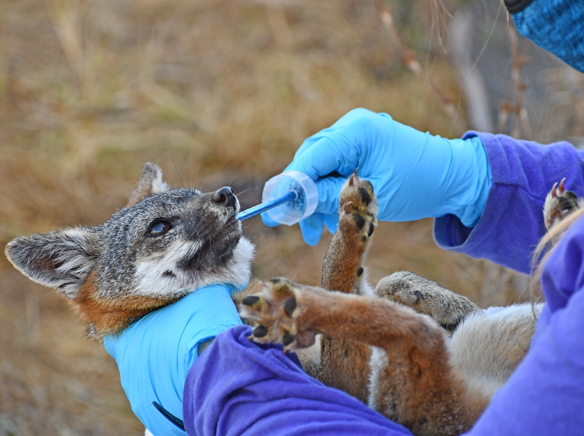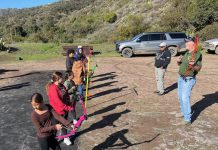
In the small, slowly-lightening hours of dawn, three conservation workers prepared to spend six weeks with one of Catalina Island’s most iconic endemic species: the Catalina Island fox. Each year several weeks are spent trapping and attending to these furry little omnivores, which weigh in at approximately 4-6 pounds. Though fox processing doesn’t begin until first light, there is plenty of preparation work that needs to be done each day.
Between October and December, Conservancy Wildlife Biologist Emily Hamblen led a team that included Conservancy Conservation Operations Coordinator Becky Rudy and Dr. Peter Sharpe from the Institute for Wildlife Studies to study and care for this federally threatened species. Before they each set out to check their respective trap lines, the team meets at Middle Ranch, the hub of Conservancy conservation operations. Supplies including vaccines, syringes and blood draw vials for research, mite and flea medicine, radio collars, tick removal equipment, food for bait, and more, all need to be gathered each morning while the moon still shines so that the first foxes of the day can be processed as soon as light reaches the Island.
“We work pretty long days during fox trapping depending on where we are on the Island. When we trap on the West End, I’m at the office at 3:30 a.m. to prepare before an hour and a half drive to the first foxes,” said Hamblen.
Safe and effective live traps are used to collect foxes around the Island, focusing on a different section or trap line each week. Each trap is modified with a flexible bite bar so that foxes do not chip their teeth once they are captured. Once a team member reaches their first trap, hands-on work begins. Each fox is different. Dr. Sharpe, who has been trapping foxes around the Channel Islands for more than 30 years, created a handy flow chart to help quickly determine the needs of each fox. All starts with checking to see if the individual has a PIT tag (passive integrated transponder, a.k.a. microchips) to determine whether or not the fox has already been processed.
“It’s basically what we go through with each fox,” said Dr. Sharpe. “Whether it has been caught before, whether it’s a new fox, whether it’s been caught this season – there’s a different procedure for each one. It determines whether or not you draw blood, whether or not you give them vaccinations for rabies and distemper, whether or not you swab their ears for a study” and a litany of other options, including whether the fox receives a collar and becomes a sentinel animal.
Sentinel animals are unvaccinated, collared animals that are regularly tracked. Based on health and behavior, these particular foxes can provide a warning, analogous to a canary in a coal mine, should something inauspicious reach the Island.
“We weren’t doing regular trapping in the 90s and we almost lost the foxes on Catalina island,” said Dr. Sharpe, who believes he collected the fox with the first confirmed case of canine distemper virus in that time period. “Continuing annual trapping at some level to monitor their population health and to have some animals that are radio collared so we can go out semi-regularly and track them down helps as an early warning system for potential disease on the island.”
Rudy’s favorite part of fox trapping is removing these radio collars, which only stay on foxes for a maximum of three years. “They did their job and helped us out, so it’s always fun to see them run off without their collars,” she said. Her least favorite aspect of fox trapping season? “I don’t think I have a least favorite, unless it’s pulling ticks. But it’s all great – except scrubbing cages.” Up to 49 traps are used on each trapline, and they are scrubbed down at the end of each week so diseases are not transmitted between different parts of the island.
Fox trapping isn’t all handling the animals. Blood taken each day needs to be processed and all of the data from the day of trapping is inputted into a sheet that is constantly updated to ensure that the same fox isn’t processed more than once each season.
One goal is to have as little hands-on interaction with the animals. “Foxes are wild animals, and as cute and cuddly as they look, any time that they’re out of their natural environment could potentially be very stressful to them and we work very hard to minimize that.”
Hamblen added that reducing the amount of hands-on interaction with wild animals is important not only for their stress levels, but also for their behavior and future survival.
“Our Catalina Island foxes are wild animals – they are very beautiful charismatic animals, but it’s very important that you just let them be. Don’t feed them, don’t try to pet them,” she cautioned. “When we start to try to include them into our life by feeding them, they become too comfortable with humans. They get into fights with cats and dogs, they get fleas and various other ectoparasites, and they get hit by cars when they’re right next to the road waiting for handouts. to The best way you can help the foxes is to just enjoy them in their natural habitat and let them walk by.”
Though it is an expensive and time-consuming process, continuing to monitor foxes each year is of vital importance.
“It is incredibly important that we continue to invest in trapping because the Channel Island fox is a conservation-reliant species. That means without constant help from people, they would probably go extinct,” said Hamblen. During trapping season, biologists gather data for research while providing foxes with vaccines for canine distemper virus and rabies, administer Ivermectin to reduce ear mites and Frontline to reduce fleas and ticks. “Without all of those interventions, if we had a rabies or canine distemper outbreak, we could lose the population. Trying to bring a population back from essentially extinction, is not only very expensive, but you’d have lost all of that genetic diversity and you can’t get that back,” she added.
Fox trapping occurs on other Islands, but is particularly key on Catalina.
“It’s very important because we have so many people come to the island,” said Rudy. “That’s one of the ways we’re different from the other Channel Islands: We typically have more than 1 million visitors a year. Those visitors are coming sometimes with their own pets – sometimes vaccinated, sometimes not. We have a huge community of boaters that come to all the different coves around the Island, and with the raccoon problem on the mainland there can be stowaways aboard their personal boats.” Canine distemper virus was originally introduced to Catalina due to a stowaway raccoon from the mainland. “It’s important to keep doing this because we continually have a threat to the fox population” because of the accessible nature of Catalina Island.
“The Catalina Island fox project is an incredible example of how the entire Conservancy plays a role in saving this species. Without the facilities team, we wouldn’t be able to drive any of the roads needed to get to trap locations. They also “keep the lights on in our clinic so that we can treat injured foxes. Without the education department, we wouldn’t be able to spread the knowledge of what we’re learning to allow visitors and locals to enjoy wildlife in a deeper way. And without development, we wouldn’t be able to raise funds and get the message out to our generous donors on the importance of this project,” said Hamblen.










